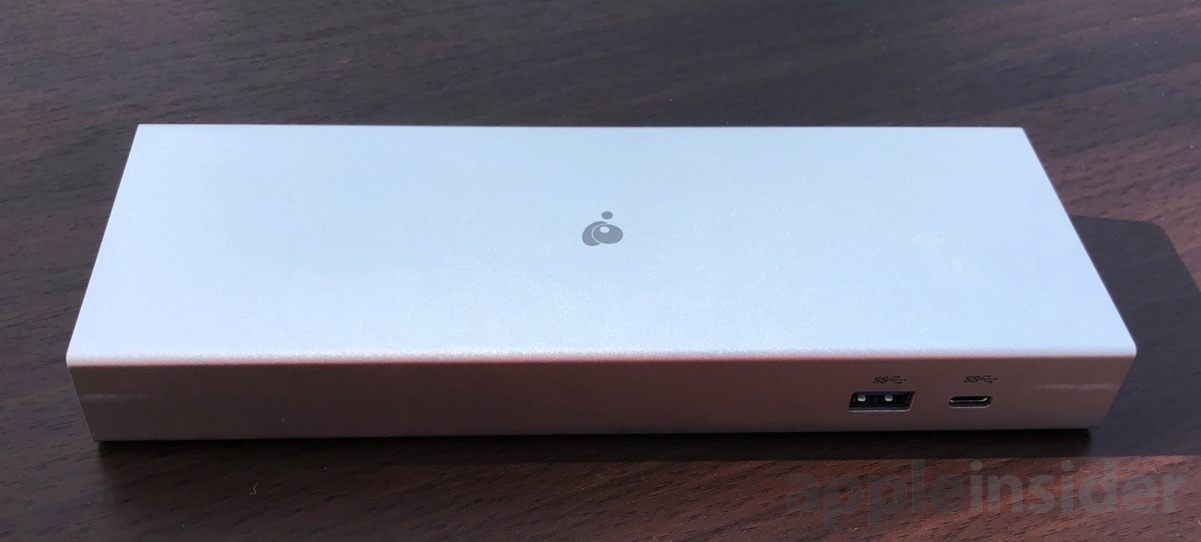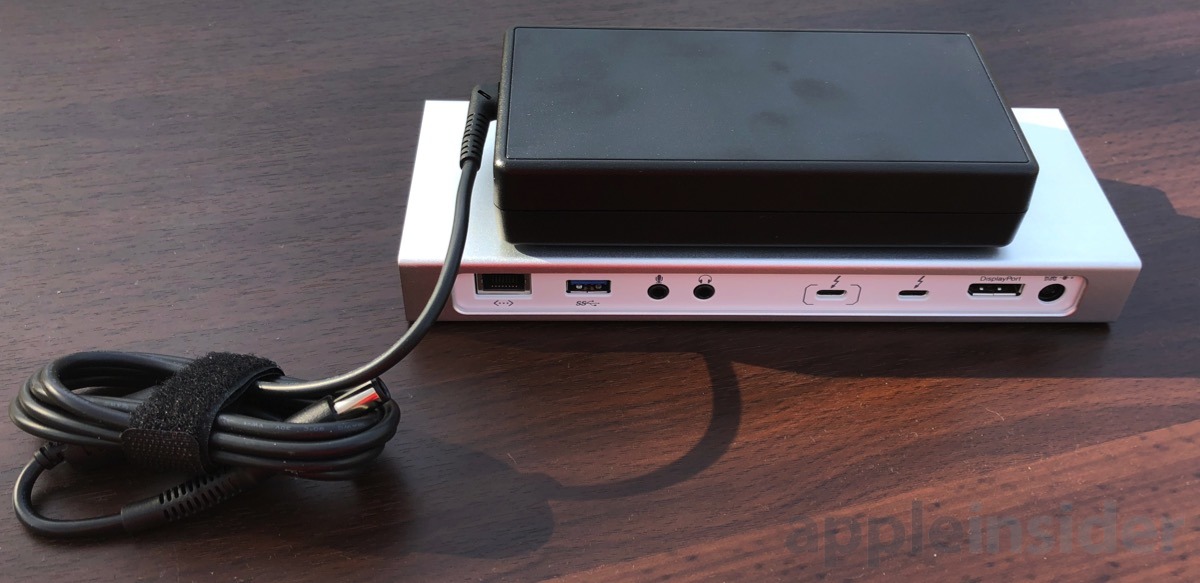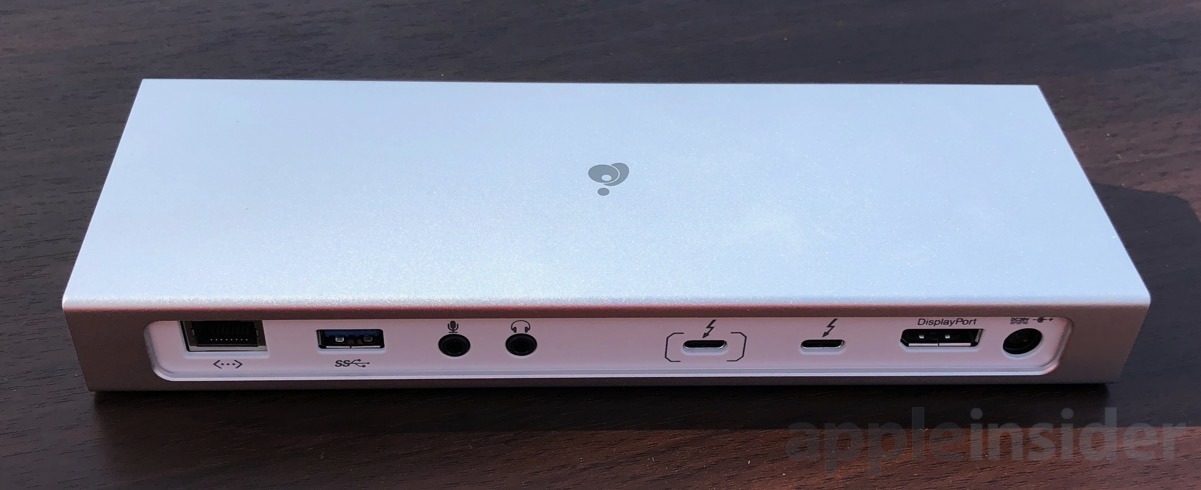Iogear is back with another Thunderbolt 3 dock with some connectivity and power improvements including a front-mounted USB 3.1 generation 1 type-C port.
The Iogear Quantum Thunderbolt 3 Pro 85 Thunderbolt 3 dock (model GTD735) is just about the same size as the rest of the docks we've looked at, minus a few of the more vertically-oriented ones. And like all of the Thunderbolt 3 docks we've seen so far, the power supply is still pretty giant.
Iogear has changed up the available ports a bit since the last release. On the front, the new dock has a 5Gbit/sec USB 3.1 type C generation 1 port, and a USB 3.0 type A 5Gbit/sec port.
On the back is a fairly standard assortment of ports. Standard ports include the two USB-C Thunderbolt 3 ports capable of providing 85W of charging power which is an improvement over the 15W on the previous Iogear dock, one USB 3.0 type A port, Gigabit Ethernet, and a 4K DisplayPort capable of 60 Hz refresh. A discrete microphone jack, plus another for a headset round out the ports.
Also, like most of the docks, there's an enclosed, short, passive Thunderbolt 3 cable included that is mostly useless for more than just testing the device out when you get it. So, like with nearly every other Thunderbolt 3 examination we've done, plan on $50 or more for a longer cable in most situations in a separate purchase.
Initial examination of connectivity still shows good dual-4K support, with the DisplayPort and the Thunderbolt 3 pass-through port utilized for displays.
We've only performed rudimentary examinations of the dock so far. We can say that the USB 3.1 Type C port on the front and the pass-through Thunderbolt 3 port support UASP for the fastest transfers possible given the limitations of each port. We've also tested connecting a SSD in conjunction with a pair of 4K monitors and haven't seen any issues — but a more detailed benchmark breakdown will wait for a full review.
What we do like is the lack of heat pouring off the device. With nearly every other dock we've used, the cases get pretty hot to the touch, and we've been reluctant to mount them to a monitor, or to put them in an enclosed space out of the way. This isn't the case with the Iogear Quantum Thunderbolt 3 Pro 85, so it's a bit easier to jam the dock someplace and not worry about an overheat situation.
We'll be examining the GTD735 a bit more in the coming weeks.
The Iogear GTD735 Thunderbolt 3 dock retails for $299. However, it is routinely available from Amazon for less than $250.
 Mike Wuerthele
Mike Wuerthele








-m.jpg)






 Charles Martin
Charles Martin


 Wesley Hilliard
Wesley Hilliard
 Stephen Silver
Stephen Silver
 William Gallagher
William Gallagher

 Marko Zivkovic
Marko Zivkovic







5 Comments
My own experience with business type users are that they will take their laptops home and on business trips where they are willing to deal with the limitations inherent in a portable device. But, when they return to the office they want to simply drop it onto a dock and start using high end, professional keyboards, screens and other peripherals.
This concept could work for both the high end, professional MBP user as well as the more casual user of consumer grade MacBooks an MacBook Airs: Those who drop their laptop into their back pack in the morning then, on return home in the evening, would like access to high end keyboards, large screens, etc. etc, etc...
Pitiful number of additional ports for $299. I went with the OWC Thunderbolt3 dock. It only provides 65W, but that's enough to keep my 15" 2016 MBP going for the workday.
These TB3 docks have been completely underwhelming to me. It's the reason why I unpacked and un-retired by Apple TB2 monitor and continue using it for my 2017 MBP. There are just one too many compromises.
If I'm going to pay $300-$400 for a TB3 dock, then cram it with as much of the current-to-future ports as possible, and in a logical way.
Place at least one USBc port, USB-A, and SD card slot on the front, and everything else (and then some) on the back. The power bricks are a conundrum to me as I understand why they are so big to support the MBP power requirements, yet wonder if just incorporating it as a single device design would be better to reduce cable clutter, or maybe some how make it smaller and less of the massive bricks that they currently are. Certainly much easier to replace an external power brick than an internal one but darn those things are huge.